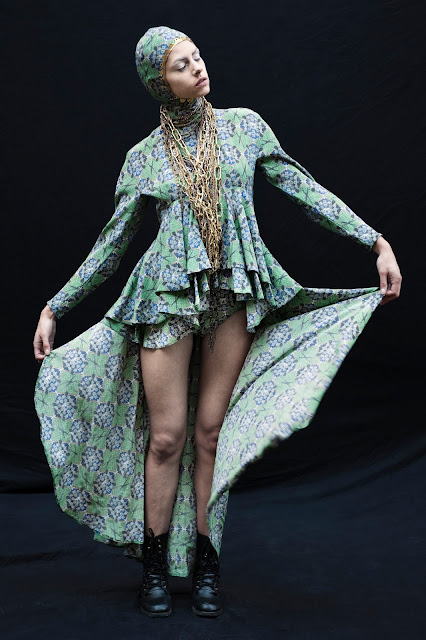They say time flies when you're having fun (or working your tail off)! I can only concurr. After four years of hard work and interesting ups and downs, I graduated in fashion design at the academy of Sint Niklaas. I'm proud to say that I did so with flying colors and top of my class!
It seems only yesterday I was just a girl with a dream.
You can read reviews of this years Fashion Show on: ° Flanders Fashion Institute website
° Belmodo blog
Presenting Gangs of NK - A/W Collection 2014-15
My collection Gangs of NK is an attempt to show the contradiction between the masses and the individual.
NK stands for North Korea and her mass culture and idoctrination. For me, gangs are a symbol for the rebellion of the individual that still doesn't leave the security of the group. The result is a womens collection that combines unexpected forms, prints and colors and yet shows a distinct unity.
The starting point for this collection was the Korean Movie 'Sympathy for Lady Vengeance' by director Park Chan Wook. I drew inspiration from different aspects of the movie which I transformed into a collection concept.
The movie is about a horrific child murder and contains a lot of nonsensical elements. I started research on Asian toys, because they have that childlike quality and can be very weird and disturbing. These toys determined a lot of the imagery and colors of the collection. I combined the very bright almost psychedelic colors of the toys with the soft pastel tones prominent in the movie.
The embroidery in the collection refers to these bizarre toys and the pixelated crosses that make out the embroidered designs connect these to mass media like computer and television, which is also very often used as a medium of mass communication in North Korea.
The diverse handling of the fabric, like the quilting techniques used on certain fabrics and the use of cut-out shapes can all be traced back to elements in nature, like ice, snow and clouds. Natural formations are very prominent in Parks movie. These irregular lines are present throughout the whole of the collection. These lines also represent the borders, rivers and roads of a country. For example, I created a print out of an aerial view of North Korea.
Research of North Korea and its culture have partly determined the overall form and cuts of the clothing. The traditional Hanbok proved to be a great inspiration. The dress shows a lowered sleeve and remarkable volumes. The shoulders follow the form of the body and I tried to achieve the same shape in the collection.
For the style and layering of the collection I looked at the typical Asian streetstyle and hip-hop culture. Pieces are combined in an unexpected way and worn on top of eachother. Futuristic prints and plaid vintage fabrics are positioned next to one another to establish an urban yet womenly feel.
This year I worked with a fantastic team to put together a studio shoot as well as a street shoot. You'll find the studio images inclosed. Don't hesitate to let me know what you think, personally I'm super excited about the result! Hope you enjoy!
Model: Mo Li (Models Office)
Production Assistant: Pieter-Jan Donders
Special thanks to: Uschi Cop, Danielle Gabriels, Louis Strijbos, Marc Cop, Cristina Chuecos, Marijke Boye, Cleo Jespers, Maryam Kamal Hedayat, Ine de Haes, Annelies Demeulenaere, Nina Van Cauwenberge, Gitte Van den Bergh, Anaïs Raes, Nadia Hostie, Danny Defoor, Elien Defoor, Ines Gabriels, Monica de Ridder, Paul Gabriels, Erik Nagels, Sylvia, Annick Schokaert van The Stitching Room
Special thanks to: Uschi Cop, Danielle Gabriels, Louis Strijbos, Marc Cop, Cristina Chuecos, Marijke Boye, Cleo Jespers, Maryam Kamal Hedayat, Ine de Haes, Annelies Demeulenaere, Nina Van Cauwenberge, Gitte Van den Bergh, Anaïs Raes, Nadia Hostie, Danny Defoor, Elien Defoor, Ines Gabriels, Monica de Ridder, Paul Gabriels, Erik Nagels, Sylvia, Annick Schokaert van The Stitching Room


.jpg)
.jpg)
.jpg)

.jpg)
.jpg)
.jpg)
.jpg)
.jpg)
.jpg)
.jpg)
.jpg)
.jpg)
.jpg)
.jpg)
.jpg)
.jpg)
.jpg)
.jpg)
.jpg)
.jpg)



























